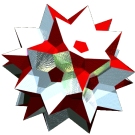|
Acronym
|
...
|
|
Name
|
Hessian polyhedron,
complex polyhedron x3-3-o3-3-o3
|
|
|
 © ©
|
|
Circumradius
|
sqrt(2/3) = 0.816497
|
|
Vertex figure
|
x3-3-o3
|
|
Coordinates
|
-
(ε3n, -ε3n, 0)/sqrt(3) & all cycl. permutations, all n
-
(ε3n, -ε3n+1, 0)/sqrt(3) & all cycl. permutations, all n
-
(ε3n, -ε3n+2, 0)/sqrt(3) & all cycl. permutations, all n
where: ε3=exp(2πi/3)=(-1+i sqrt(3))/2
|
|
Dual
|
selfdual
|
|
Face vector
|
27, 72, 27
|
|
Confer
|
- real space embedding:
-
jak
- general polytopal classes:
-
complex polytopes
|
External
links
|


|
When considered as a regular complex polyhedron, one derives its incidence structure as follows.
As the (complex) edges are x3-3-o3,
which in turn were substructures of hex, it becomes clear that those are to be searched for there.
Further the (complex) vertex figure has to be the same.
Edges here clearly are complex 3-edges.
When considered instead as a snub, one derives its incidence structure as follows.
Let's start with the pre-image of this operation, i.e. with
x2-4-o3-3-o3.
Its vertex count herein will have to be halved.
Edges here are obtained as subdimensionally degenerate remainders of the former faces, i.e.
s2-4-o3. Thus there are 72, and those are 3-edges.
The count of the sectioning facets underneath the removed vertices again is half of the former vertex count,
in fact now the other half. These sectioning facets themselves clearly are the former vertex figures.
(The remaining numbers of the incidence matrix then can easily be derived from the general
incidence matrix relation.)
Incidence matrix according to Dynkin symbol
x3-3-o3-3-o3
. . . | 27 ♦ 8 | 8
-------------+----+----+---
x3 . . | 3 | 72 | 3
-------------+----+----+---
x3-3-o3 . ♦ 8 | 8 | 27
s2-4-o3-3-o3
hemi( . . . ) | 27 ♦ 8 | 8
---------------------+----+----+---
s2-4-o3 . ♦ 3 | 72 | 3
---------------------+----+----+---
sefa( s2-4-o3-3-o3 ) ♦ 8 | 8 | 27
starting figure: x2-4-o3-3-o3
©

